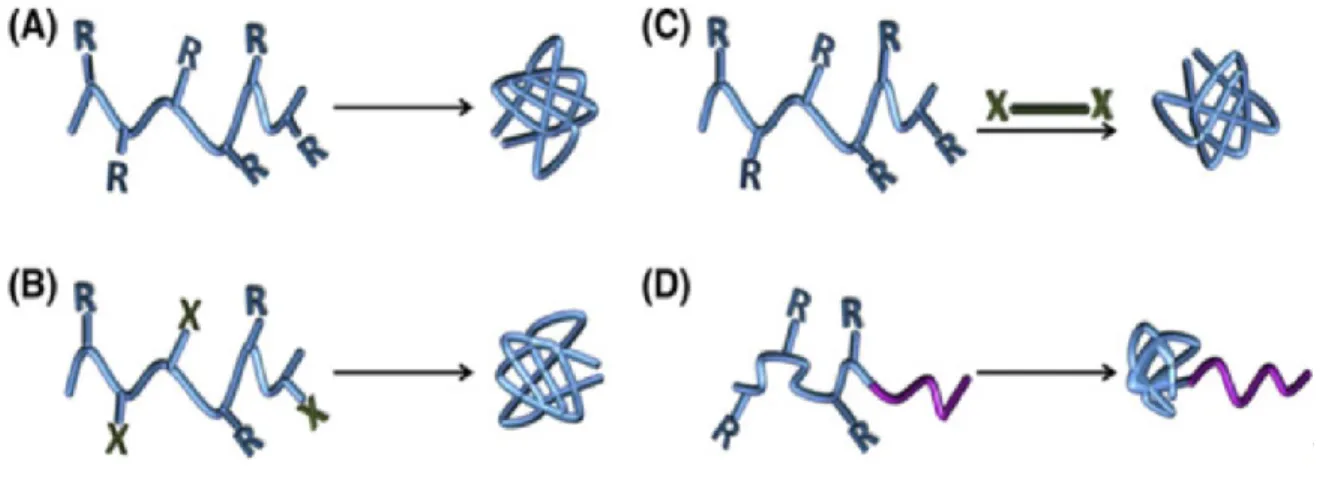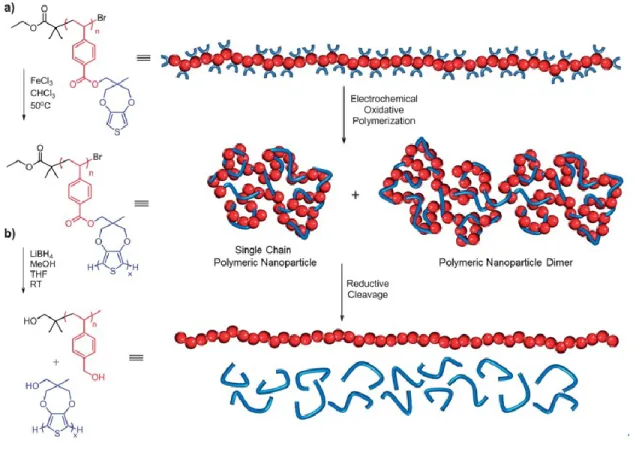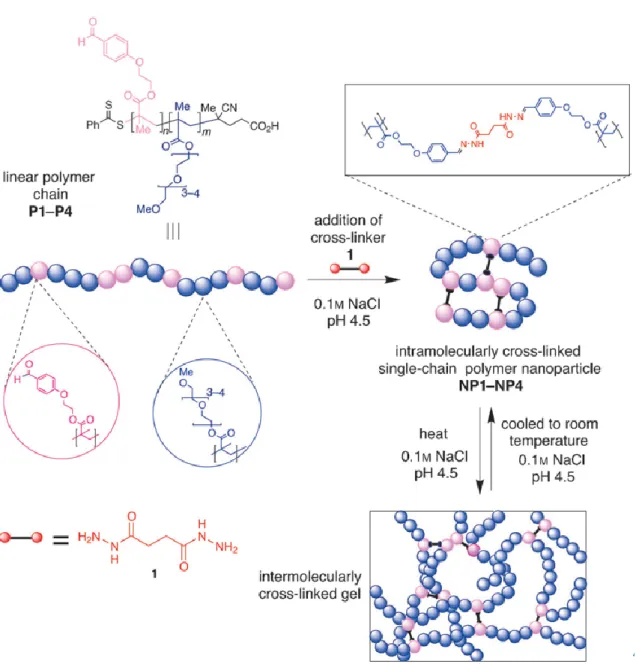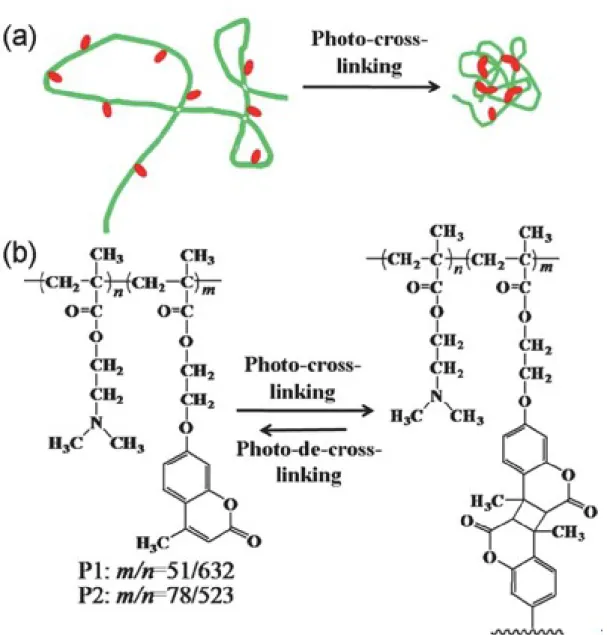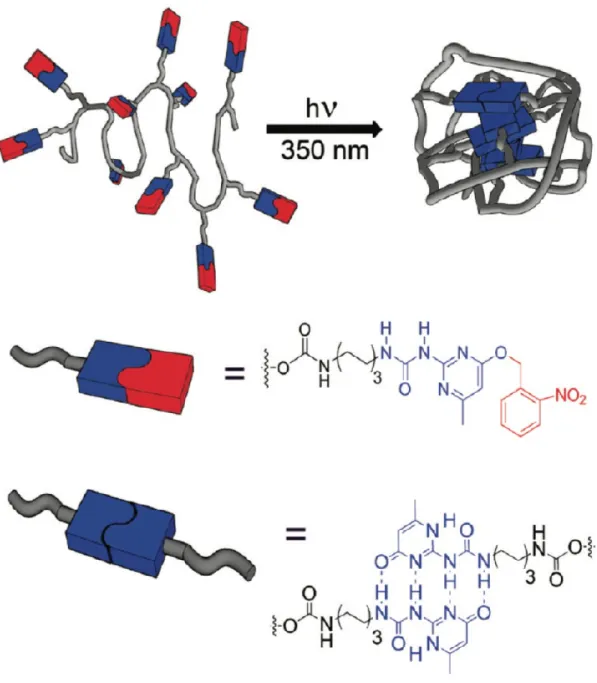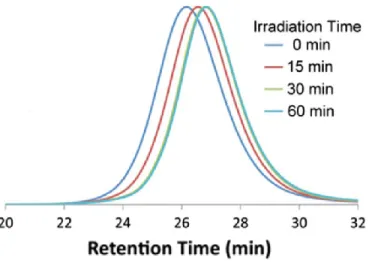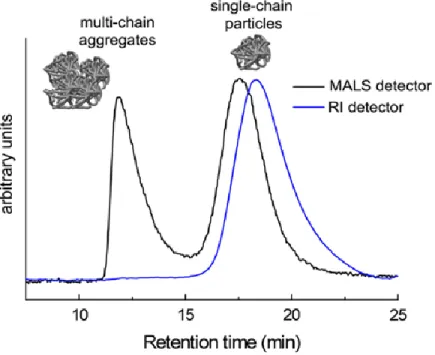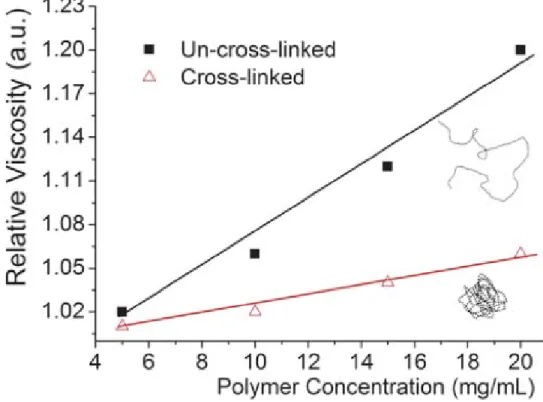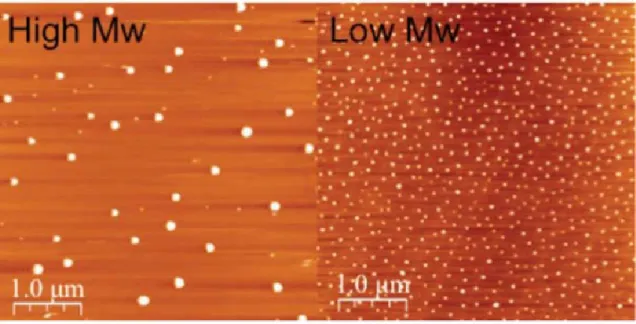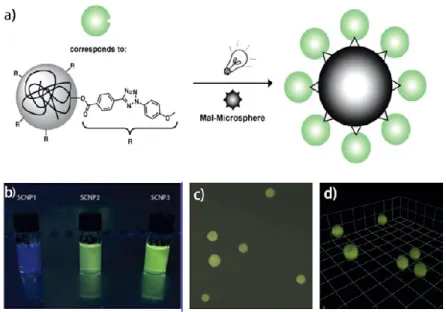DÉVELOPPEMENT DE NANOPARTICULES MULTIFONCTIONNELLES À BASE DE POLYMÈRES STIMULI-RÉPONDANTS ET FORMÉES DE CHAÎNES
INDIVIDUELLES
Par
Weizheng Fan
Thèse présentée au Département de chimie en vue
de l’obtention du grade de docteur ès science (Ph.D.)
FACULTÉ DES SCIENCES
UNIVERSITÉ DE SHERBROOKE
DEVELOPMENT OF MULTIFUNCTIONAL POLYMERIC SINGLE-CHAIN NANOPARTICLES BASED ON STIMULI-RESPONSIVE POLYMERS
by
Weizheng Fan
A Thesis
Presented to the Département of Chimie
in Partial Fulfillment of the Requirements for the Degree of
Doctor of Philosophy (Ph.D.)
FACULTÉ DES SCIENCES
UNIVERSITÉ DE SHERBROOKE
Le 28 Juillet 2017
le jury a accepté la thèse de monsieur Weizheng Fan
dans sa version finale.
Membres du jury
Professeur Yue Zhao
Directeur de recherche Département de chimie
Professeur Josée Brisson
Évaluateur externe Département de chimie
Université Laval
Professeur Pierre D. Harvey
Évaluateur interne Département de chimie
Professeur Yves Dory
Évaluateur interne Département de chimie
Professeur Jean-Philippe Bellenger
Président-rapporteur Département de chimie
SOMMAIRE
Comme je suis particulièrement intéressé par les nanosciences et les nombreuses applications des nanotechnologies, je me suis penché sur le développement de méthodes de fabrication de nanoparticules ultra-petites dont les fonctions peuvent être ajustées avec précision. Récemment, une nouvelle technologie appelée « technologie d’une seule chaîne », c’est-à-dire qui utilise une seule chaîne polymère, est devenue un sujet de recherche de plus en plus motivant pour la communauté scientifique. Cette technologie a l’avantage de dépendre d’une méthode facile de préparation de nanoparticules polymères d’une seule chaîne (SCNPs) et ayant des dimensions typiques de 1,5 à 20 nm. Leurs tailles ultra petites leur confèrent des propriétés spécifiques, ce qui permet de les utiliser comme capteurs, systèmes catalytiques, revêtements à faible viscosité, nanoréacteurs ou pour des applications biomédicales. Grâce aux contributions de nombreux scientifiques durant la dernière décennie, les méthodes de synthèse des SCNPs sont devenues très variées et représentent une technologie désormais mature. Néanmoins, de nombreux problèmes sont à résoudre dans ce domaine, ce qui permettra d’ajouter de nouvelles fonctions ou de les valoriser pour de nouvelles applications.
Les polymères sensibles à plusieurs stimuli sont une classe de matériaux intelligents dont les propriétés peuvent être modifiées par l’application d’un stimulus extérieur. Ils sont utilisés extensivement dans les domaines énergétique et biomédical. Comme leurs propriétés physiques et chimiques peuvent être modifiées aisément et efficacement par un contrôle de leur environnement externe, ces polymères sont des candidats pour fabriquer de nouvelles SCNPs.
multiples fonctionnalités car cela permet d’ouvrir la voie pour de nouvelles applications. Pour cela, de nombreux polymères sensibles à plusieurs stimuli ont été préparés comme précurseurs à des SCNPs. En concevant spécifiquement ces polymères, il fut possible d’ajouter leurs propriétés de réponse à des stimuli dans les systèmes SCNPs. Le cœur même de cette thèse consiste en trois projets qui utilisèrent trois classes de SCNPs provenant de polymères sensibles aux stimuli. Grâce à leur réponse à plusieurs stimuli, ces SCNPs remplirent de nombreuses fonctions et subirent des modifications soit de leur structure, soit de leur morphologie, soit de leurs propriétés. Et en plus de la variété de fonctions, chaque classe de SCNPs a le potentiel pour de nombreuses applications.
Dans la première étude présentée dans cette thèse (chapitre 1), nous avons préparé une classe de SCNPs photodégradables ayant une taille ajustable et inférieure à 10 nm. Il s’agit de polyesters rendus photosensibles par la présence de coumarines à l’intérieur de la chaîne principale (nommés CAPPG) grâce à la copolymérisation de coumarine diol, d’acide adipique et de propylène glycol (PPG). Cette incorporation de coumarines dans la chaîne principale permet au polymère d’être photosensible par deux façons. En effet, les coumarines peuvent se photo-dimériser, lorsqu’elles sont irradiées par des rayonnements UV (> 320 nm) en des cyclobutanes qui peuvent être ouverts à nouveau par d’autres rayonnements UV (254 nm) permettant la restauration des coumarines initiales. Cela a permis la création de SCNPs de tailles inférieures à 10 nm et incluant des propriétés de photodégradation. Cette propriété a été démontrée par une irradiation de 3 h avec des chaînes polymères de 13220 g/mol à 1385 g/mol dans les SCNPs. La taille de ces SNCPs (caractérisée par leur rayon hydrodynamique) peut être modifiée entre 3 nm et 5,3 nm en modifiant le taux de dimérisation des coumarines, ce qui est aisément obtenu en ajustant le temps d’irradiation UV. Les résultats ont démontré
synthèse de nombreux polymères précurseurs. Finalement, comme le polyester était biodégradable et biocompatible, ces SCNPs peuvent être exploitées pour des applications biomédicales.
Dans la deuxième étude effectuée au cours de cette thèse (chapitre 2), nous avons préparé un nouveau type de SCNPs multifonctionnel à partir d’un polymère cristallin liquide. Il s’agit du polyméthacrylate de [2- (7-méthylcoumaryl) oxyéthyle - co - 6-[4-(4’-méthoxyphenylazo) phénoxy] hexyle] (PAzoMACMA). Les groupements latéraux du polymère contiennent, en majorité, des azobenzènes photoisomérisables et, en minorité, des coumarines photodimérisables. Les azobenzènes servent de mésogènes pour la formation de cristaux liquides alors que les coumarines ont été utilisées pour une réticulation photoinduite et intrachaîne. Malgré les dimensions inférieures à 15 nm, le confinement et la réticulation, les phases cristallines liquides (LC) persistèrent même dans les SCNPs. Ces SCNPs cristaux liquides (LC-SCNPs) présentèrent un certain nombre de propriétés intéressantes et particulières. Alors que leurs dispersions dans le THF n’étaient pas fluorescentes, celles dans le chloroforme l’étaient. En plus, ces nanoparticules s’aggloméraient quelque peu dans le chloroforme ce qui induisait des fluorescences différentes entre des SCNPs riches en isomères cis ou riches en isomères trans des azobenzènes. A cause de la photoisomérisation des azobenzènes, ces LC-SCNPs se déformaient sous irradiation comme le font les microparticules ou les colloïdes contenant des azobenzènes. Cependant, la déformation de ces nanoparticules dépend de la longueur d’onde de lumière polarisée. Alors que sous irradiation UV polarisée à 365 nm, l’élongation des SCNPs était perpendiculaire à la polarisation de la lumière incidente, sous irradiation visible polarisée entre 400 et 500 nm, l’étirement se faisait parallèlement à la polarisation. Finalement, un nanocomposite fut
(PMMA). Si celui-ci était étiré mécaniquement, les azobenzènes s’orientaient dans la direction de la déformation induite. Ces propriétés intéressantes des LC-SCNPs que cette étude a permis de dévoiler, suggèrent de nouvelles applications potentielles.
Dans la troisième étude de cette thèse (chapitre 3), nous avons préparé une classe de SCNPs sensibles à la présence de CO2 et leurs agrégats micellaires auto-assemblés. D’un côté, des
SCNPs ont été préparées à partir d’un polyméthacrylate de {(N, N-diméthylaminoéthyle)-co-4-méthyl-[7-(méthacryloyl)-oxyéthyl-oxy] coumaryle} (PDMAEMA-co-CMA). Lorsqu’elles sont dispersées en solution aqueuse, les nanoparticules individuelles peuvent subir des cycles réversibles d’expansion et de rétrécissement sous une stimulation alternative de CO2 et de N2 qui vont protoner et déprotoner les amines tertiaires. D’un autre côté, des
SCNPs de type ‘Janus’ (SCJNPs) ont été préparées à partir d’un copolymère dibloc amphiphile : PS-b-P(DMAEMA-co-CMA) (PS correspond au polystyrène qui est hydrophobe). Ce type de SCJNPs peut s’autoassembler sous forme de micelles en solution aqueuse. Sous stimulation CO2 ou N2, l’expansion ou le rétrécissement à l’intérieur des
particules permet de grands changements de volume. En plus, ces particules ont été étudiées comme potentiels nanoréacteurs pour des nanoparticules d’or (AuNPs) que ce soit sous formes SCNPs ou micelles SCJNPs. La vitesse de formation des AuNPs augmente sous bullage de CO2 et décroît sous N2. Cela permet de rendre possible cette réaction contrôlable
par ces deux gaz. Qui plus est, utiliser des micelles de SCJNPs dont le volume peut être modifié sur un large intervalle en changeant l’intensité de la stimulation de CO2, permit
d’obtenir des AuNPs de taille variable.
ABSTRACT
With interests on nanoscience and nanotechnology for many applications, there is a demand for development of fabrication technology of ultra-small nano-size objects that allow for precise size control and tailored functionality. Recently, a new technology called ‘single-chain technology’, which manipulates a single polymer ‘single-chain, becomes a rapidly-growing research topic. This technology provides a facile method to prepare polymer single-chain nanoparticles (SCNPs) with a typical size of 1.5-20 nm. Due to the ultra-small size-enabled unique properties, SCNPs have wide range of applications, including sensor, catalytic system, low viscosity coating, nanoreactor and biomedical applications. Through the contributions by many scientists in the past decade, the synthetic methodologies to fabricate SCNPs have been reported using various chemistries and been getting mature. However, there are still several unsolved problems in the field of SCNPs including functions and application.
Stimuli-responsive polymers, as a class of smart materials whose properties can be changed by responding to external stimuli, have been widely used in energy and biomedical applications. Since their chemical and physical properties can be changed easily and efficiently via environmental control, stimuli-responsive polymers provide a potential pathway to preparing functional SCNPs.
In this thesis, we are focusing on developing functional SCNPs, especially systems with multi-functions, and expanding their applications. To achieve this target, various stimuli-responsive polymers were prepared as polymer precursors and their stimuli-stimuli-responsive properties were introduced into the SCNP systems by rational design of their chemical structures. The core of this thesis is comprised of three projects which deal with three classes
of SCNPs from stimuli-responsive polymers. These stimuli-responsive SCNPs perform multi-functions and undergo certain change either in structure or morphology and properties. In addition, according to their variety of functions, each class of multi-functional SCNPs has diverse potential applications.
In the first study presented in the thesis (Chapter 1), we prepared a class of sub-10 nm photodegradable and size-tunable SCNPs based on photo-responsive main-chain coumarin-based polyesters Poly{[7-(hydroxypropoxy)-4-(hydroxymethyl)coumarin adipate]-co- (polypropylene glycol adipate)} (CAPPG) through copolymerization of coumarin diol, adipic acid and polypropylene glycol (PPG). By incorporating coumarin moieties into the chain backbone of a polyester, dual photo-responsive reaction, i.e. photo-dimerization (>320 nm) and photo-induced chain scission (254 nm), occur under two different wavelengths of UV irradiation, enabling the preparation of sub-10 nm SCNPs and their photo-degradation property. The photo-degradability of SCNPs is evidenced under 254 nm UV irradiation for 3 h, which molecular weight of SCNPs decreasing from 13220 g/mol to 1385 g/mol. Moreover, the size of SCNPs can be tunable from 5.3 nm to 3 nm (hydrodynamic diameter) by varying the dimerization degree of coumarin moieties, that is simply controlled by the UV irradiation time. These results demonstrate a facile method to control the size of SCNPs without the need for synthesizing different polymer precursors. Finally, due to the biocompatible and biodegradable nature of polyester as polymer precursor, the SCNPs with photo-degradability and size-tunability have the potential to be exploited for biomedical applications.
In the second study realized in this thesis (Chapter 2), we prepared a new type of multi-functional SCNPs from a side-chain liquid crystalline polymer (SCLCP), namely
poly{6-[4-ethyl-oxy]coumarin} (PAzoMACMA). The polymer’s side groups comprise photo-isomerizable azobenzene in majority and photo-dimerizable coumarin in minority, with the former as mesogens and the latter for intra-chain photo-crosslinking. Despite the sub-15 nm size, confinement and crosslinking, the liquid crystalline (LC) phases of bulk PAzoMACMA persist in SCLCPs. Such LC-SCNPs exhibit a number of interesting and peculiar properties. While their dispersion in THF is non-fluorescent, when dispersed in chloroform, the nanoparticles appear to agglomerate to certain degree and display significant fluorescence that is different for SCNPs rich in the trans or cis isomer of azobenzene. The azobenzene LC-SCNPs also undergo photo-induced deformation, similar to azobenzene micro- or colloidal particles. However, the elongational deformation of the nanoparticles is dependent upon the linearly polarized excitation wavelength. While under polarized 365 nm UV irradiation the SCNP stretching direction is perpendicular to the light polarization, under polarized 400-500 nm visible light irradiation, the stretching takes place along the light polarization direction. Finally, an all-polymer nanocomposite was prepared by dispersing the LC-SCNPs in poly(methyl methacrylate) (PMMA), and mechanically stretching-induced orientation of azobenzene mesogens developed along the strain direction. The interesting properties of LC-SCNPs unveiled in this study suggest new possibilities for applications including bio-imaging and LC materials.
As the third study in this thesis (Chapter 3), we studied a class of CO2-responsive SCNPs
and their self-assembled micellar aggregates. On one hand, SCNPs are prepared from a random copolymer of poly{(N,N-dimethylaminoethyl methacrylate)-co-4-methyl-[7-(methacryloyl)oxyethyl-oxy]coumarin} (P(DMAEMA-co-CMA)). When dispersed in aqueous solution, individual nanoparticles can undergo reversible swelling/shrinking under
tertiary amine groups. On the other hand, tadpole-like single-chain ‘Janus’ nanoparticles (SCJNPs) are prepared using an amphiphilic diblock copolymer of PS-b-P(DMAEMA-co-CMA) (PS is hydrophobic polystyrene). This type of SCJNPs can self-assemble into core-shell micellar aggregates in aqueous solution. Under CO2/N2 stimulation, the collective
swelling/shrinking of SCJNPs within the micelle results in large, reversible volume change. In addition, both P(DMAEMA-co-CMA) SCNPs and PS-b-P(DMAEMA-co-CMA) SCJNP micelles are explored as gas-tunable nanoreactors for gold nanoparticles (AuNPs). The rate of AuNP formation increases under CO2 stimulation and decreases upon N2 bubbling, which
makes it possible to tune the reaction rate up and down (on/off switching) by using the two gases. Moreover, using the micelles of SCJNPs, whose volume can be controlled over a wide range by adjusting the CO2 stimulation strength, variable-size AuNPs and their aggregates
are obtained with continuous redshift of the surface plasmon resonance (SPR) into the long wavelength visible light region.
Keywords: Polymer science; Single-chain nanoparticles; Stimuli-responsive polymers;
ACKNOWLEDGEMENT
After the accomplishment of this thesis, I would like to express my sincere gratitude to my supervisor Prof. Yue Zhao for his guidance, patience, encouragement and supports during my research. I appreciate him to provide me an opportunity to do research which I am interested in and support me to realize my ideas to some extent. I really learned a lot from Prof. Zhao, not only for the knowledge of science, but also the attitude for research. Also I would thank him to give me the financial support which make me finish my PhD program.
I would like to thank two members of my doctoral committee, who are also in the jury of my thesis, Prof. Jean-Philippe Bellenger and Prof. Pierre D. Harvey, as well as all the professors and staff working in the Department of Chemistry, Université de Sherbrooke for their kind help. I would like to thank Prof. Josée Brisson (Université Laval) and Prof. Yves Dory for serving in the jury of my thesis. I also would like to thank Prof. Jérôme Claverie and Dr. René Gagnon for the triple detection size exclusion chromatography tests conducted in a project.
I acknowledge the following people, my colleagues and dearest friends, who made my stay in Sherbrooke full of joys and memories: Mrs. Xia Tong, Dr. Olivier Boissière, Dr. Bing Yu, Dr. Feng Shi, Dr. Hongji Zhang, Dr. Shangyi Fu, Dr. Guo Li, Dr. Qiang Yan, Dr. Hu Zhang, Dr. Aurélie Lespes, Dr. Shengwei Guo, Dr. Xin Zhao, Dr. Juan Xuan, Dr. Rong Yang, Dr. Hojjat Seyedjamali, Mr Jun Xiang, Mrs. Hui Xiao, Mr. Damien Habault, Mr. Farhad Farnia, Mr. Xili Lu, Mr. Feijie Ge, Mr. Liangliang Dong, Mrs. Amélie Augé, Mr. Ricardo Da Silva Lemos, and Mrs. Laura Mourot.
wish to thank my parents that they have continuously supported me both morally and economically after my arrival in Canada, without which I would not have a chance to persevere to the end.
Finally, I would like to acknowledge the following organizations for their financial support: Natural Sciences and Engineering Research Council of Canada (NSERC), Le Fonds de recherche du Québec: Nature et technologies (FQRNT), Centre for Self-Assembled Chemical Structures (CSACS) and La Fondation de Université de Sherbrooke.
TABLE OF CONTENT
SOMMAIRE ... iv
ABSTRACT ... viii
ACKNOWLEDGEMENT ... xii
TABLE OF CONTENT ... xiv
LIST OF SCHEMES ... xix
LIST OF FIGURES ... xx
LIST OF TABLES ... xxviii
INTRODUCTION ... 1
I.1 Synthetic Methodology of Single-Chain Nanoparticles ... 4
I.1.1 Covalent crosslinking chemistry. ... 6
I.1.2 Dynamic covalent crosslinking chemistry... 12
I.1.3 Non-covalent crosslinking chemistry ... 16
I.2 Characterization Techniques of Single-Chain Nanoparticles ... 21
I.2.1 Size-Exclusion Chromatography (SEC) ... 21
I.2.2 Viscometry ... 24
I.2.3 Nuclear Magnetic Resonance Spectroscopy (NMR) ... 25
I.2.4 Atomic Force Microscope (AFM) ... 26
I.2.5 Other characterization techniques ... 28
I.3 Development of Functional Single-Chain Nanoparticles ... 29
I.3.1 Functional SCNPs based on rational design of polymer structure ... 29
I.3.2 Functional SCNPs based on stimuli-responsive polymers ... 32
I.6 Brief Background of Stimuli-Responsive Polymers ... 37
I.6.1 Stimuli-responsive polymers sensitive to various stimuli ... 38
I.6.1.1 Light as stimulus ... 38
I.6.1.2 Temperature as stimulus ... 39
I.6.1.3 pH as stimulus ... 40
I.6.1.4 CO2 as stimulus ... 40
I.6.2 Stimuli-responsive molecular structures used in this thesis ... 40
I.6.2.1 Coumarin ... 40
I.6.2.2 Azobenzene ... 42
I.6.2.3 2-(Dimethylamino)ethyl methacrylate (DMAEMA) ... 42
I.7 Objective of the Thesis ... 43
CHAPTER 1 PHOTODEGRADABLE AND SIZE-TUNABLE
SINGLE-CHAIN NANOPARTICLES PREPARED FROM A SINGLE MAIN-SINGLE-CHAIN
COUMARIN-CONTAINING POLYMER PRECURSOR... 46
1.1 Introduction ... 46
1.2 Experimental Section ... 48
1.2.1 Materials ... 48
1.2.2 Synthesis of the coumarin monomer ... 49
1.2.2.1 Synthesis of 7-hydroxy-4-(chloromethyl) coumarin ... 49
1.2.2.2 Synthesis of 7-hydroxy-4-4(hydroxymethyl) coumarin ... 49
1.2.2.3 Synthesis of 7-(hydroxypropoxy)-4-(hydroxymethyl) coumarin ... 49
1.2.3 Synthesis of the coumarin-containing polymer precursor CAPPG ... 50
1.2.4 Preparation of single-chain nanoparticles of CAPPG... 50 1.2.5 SEC measurements of CAPPG polymer precursor, SCNPs and SCNPs after
photo-degradation ... 53
1.2.6 Instruments and measurements ... 54
1.3 Results and Discussion ... 55
1.4 Conclusion ... 61
1.5 Statement of Contribution ... 63
CHAPTER 2 PHOTO-RESPONSIVE LIQUID CRYSTALLINE POLYMER
SINGLE-CHAIN NANOPARTICLES ... 64
2.1 Introduction ... 64
2.2 Experimental Section ... 67
2.2.1 Materials ... 67
2.2.2 Synthesis of polymer precursor PAzoMACMA ... 68
2.2.3 Preparation of PAzoMACMA single-chain nanoparticles ... 68
2.2.4 Characterization of single-chain nanoparticles ... 69
2.2.5 Photo-induced deformation of single-chain nanoparticles ... 70
2.2.6 Nanocomposite preparation and characterization ... 70
2.2.7 Instruments and measurements ... 71
2.3 Results and Discussion ... 72
2.3.1 Design of polymer precursor ... 72
2.3.2 Single-chain nanoparticle preparation and characterization ... 73
2.3.3 Liquid crystal order in PAzoMACMA SCNPs ... 77
2.3.4 Optical behaviours of LC-SCNPs ... 79
2.3.5 Photo-induced deformation of LC-SCNPs ... 81
2.3.6 Stretching-induced orientation in a nanocomposite with LC-SCNPs ... 84
2.5 Statement of Contribution ... 87
CHAPTER 3 CO
2-RESPONSIVE POLYMER SINGLE-CHAIN
NANOPARTICLES FOR GAS-SENSITIVE SELF-ASSEMBLY AND
NANOREACTORS ... 88
3.1 Introduction ... 88 3.2 Experimental Section ... 92 3.2.1 Materials ... 92 3.2.2 Synthesis of P(DMAEMA-co-CMA) ... 93 3.2.3 Synthesis of PS-b-P(DMAEMA-co-CMA) ... 93 3.2.3.1 Synthesis of PS macro-initiator ... 94 3.2.3.2 Synthesis of PS-b-P(DMAEMA-co-CMA). ... 953.2.4 Preparation of single-chain nanoparticles of P(DMAEMA-co-CMA). ... 95
3.2.5 Preparation of tadpole-like single-chain 'Janus' nanoparticles and self-assembly. ... 96
3.2.6 Synthesis of gold nanoparticles using CO2-responsive nano-reactors of SCNPs or SCJNP micelles... 97
3.2.7 Instrumentation and characterization methods. ... 98
3.3 Results and Discussion ... 100
3.3.1 Preparation and characterization of P(DMAEMA-co-CMA) SCNPs ... 100
3.3.2 Preparation and characterization of PS-b-P(DMAEMA-co-CMA) SCJNPs .... 101
3.3.3 CO2-responsive single-chain nanoparticles of P(DMAEMA-co-CMA). ... 104
3.3.4 CO2-responsive micellar aggregates of single-chain 'Janus' nanoparticles of PS-b-P(DMAEMA-co-CMA). ... 106
3.3.6 Gas-tunable size of AuNPs using micelles of SCJNPs as nanoreactors. ... 111
3.4 Conclusion ... 116
3.5 Statement of Contribution ... 117
CHAPTER 4 GENERAL DISCUSSION AND PERSPECTIVE ... 118
4.1 General Discussion ... 118
4.2 Perspective ... 121
4.2.1 Compartmentalized ‘Janus’ single-chain nanoparticles with multi-functions ... 122
4.2.2 Stimuli-responsive single-chain nanoparticles in drug delivery system ... 123
CONCLUSION ... 125
LIST OF SCHEMES
Scheme 1. Photochemical reactions of coumarin compound. ... 41
Scheme 2. Photoisomerization of azobenzene. ... 42
Scheme 3. Protonation/deprotonation of PDMAEMA by pH or gas stimulation. ... 43
Scheme 4. Synthesis procedure for the CAPPG polymer precursor ... 51
Scheme 5. Photo-crosslinking and photo-degradation of SCNP of the main chain coumarin-containing polymer. Under the 254 nm UV irradiation, cleavage of the coumarin-4-yl methyl ester, resulting in chain scission, can occur with coumarin in the monomeric form (as drawn in the scheme) or in the dimer form (not shown). ... 59
Scheme 6. Synthesis procedure of PAzoMACMA polymer precursor ... 69
Scheme 7. Chemical structure of P(MEO2MA-co-MAA)-b-PEO-b P(MEO2MA-co-MAA) ... 92
LIST OF FIGURES
Figure 1. Conceptual illustration of single-chain folding of linear polymer. ... 2 Figure 2. Schematic representation of the four strategies utilized for the synthesis of SCNPs:
(A) Homo-functional chain collapse; (B) Hetero-bifunctional chain collapse; (C) Cross-linker-mediated chain collapse; (D) One-block collapse of diblock or triblock copolymers. ... 5
Figure 3. Synthetic route and graphical representation of (a) the oxidative polymerization of
pendant ProDOT groups of poly(ProDOT-Sty) yielding conjugated polymeric nanoparticles and (b) their subsequent reduction to poly(vinylbenzyl alcohol) and poly(ProDOT-OH). ... 9
Figure 4. Conjugation of polymer chains to form intramolecularly crosslinked SCNPs, and
their subsequent reversible transformation into an intermolecularly crosslinked hydrogel. ... 14
Figure 5. (a) Schematic illustration of preparation of polymer SCNPs through intra-chain
photo-crosslinking. (b) Chemical structures of coumarin-containing random copolymers of P(DMAEMA-co-CMA) and the reversible photo-crosslinking reaction activated by UV light at two different wavelengths. ... 15
Figure 6. UV irradiation induced collapse of a single polymer chain into a nanoparticle for
an example that the functional group with hydrogen bonding units are protected in some way to prevent forming aggregation. ... 18
Figure 7. SEC traces of polymer precursor and single-chain nanoparticles with different
Figure 8. MALS and RI detection traces for SEC of SCNPs highlighting the ability of MALS
to detect large, multi-chain aggregates. ... 23
Figure 9. Relative viscosity of linear polymer and SCNPs at various concentrations... 25 Figure 10. AFM images of well-separated single-chain nanoparticles prepared on mica (a,b)
and graphite (c, d) under dilute concentration. ... 27
Figure 11. AFM images of SCNPs display the relationship between molecular weight and
single-chain nanoparticles size. ... 27
Figure 12. (a) Synthetic scheme for the proof of principle reaction of the profluorescent
SCNP with Maleimide-functional microspheres. (b) Image of solution of SCNP in THF irradiated with a hand-held UV-lamp (366 nm). (c, d) Fluorescence microscopy image and three-dimensional reconstruction of a confocal image stack of SCNP-functionalized microspheres. ... 30
Figure 13. Processes for preparation of polymeric mono-functional nanoparticles. ... 31 Figure 14. Schematic depiction of the self-assembly of monotailed SCNPs into aggregates
with different morphologies. ... 32
Figure 15. Schematic representation of the formation of SCNPs via intramolecular
host-guest interaction and the voltage responsiveness of SCNPs. ... 34
Figure 16. (a) Transmittance change as a function of temperature for SCNPs solution with
different photo-dimerization degree (b) Photographs of SCNP solution at 40oC with
different dimerization degree which demonstrate the photo-tunable LCST properties of SCNPs. ... 34
Figure 18. Schematic illustration for the preparation of variable-size SCNPs using a single
polymer precursor based on intra-chain photo-dimerization of coumarin moieties and the photodegradable feature of the SCNPs. ... 48
Figure 19. 1H-NMR spectrum of 7-hydroxy-4-(chloromethyl) coumarin (a) (DMSO-d6). 51 Figure 20. 1H-NMR spectrum of 7-hydroxy-4-4(hydroxymethyl) coumarin (b) (DMSO-d6).
... 52
Figure 21. 1H-NMR spectrum of 7-(hydroxypropoxy)-4-(hydroxymethyl) coumarin (c) (in
DMSO-d6). ... 52
Figure 22. 1H-NMR spectrum of the CAPPG polymer precursor (in CDCl
3). ... 53 Figure 23. (a) Absorption spectra of CAPPG in CHCl3 (0.2 mg/mL) recorded after different
times of >320 nm UV irradiation showing intra-chain photodimerization (crosslinking). Inset is the plot of the photodimerization degree of coumarin vs. UV irradiation time. (b) SEC traces of the CAPPG precursor, SCNPs of varying photocrosslinking density obtained by exposing the same dilute CAPPG solution (0.2 mg/mL) to >320 nm UV light for different times, and SCNPs of the highest crosslinking density after subsequent 254 nm UV irradiation for 3 h. (c) AFM and (d) TEM image of the SCNPs with the highest crosslinking density, cast from a dilute polymer solution in CHCl3 (0.02 mg/mL).
... 57
Figure 24. SEC traces over the full retention time scale for the CAPPG precursor, its SCNPs
prepared upon 30 and 120 min >320 nm UV irradiation, respectively, and the photodegraded SCNP obtained after 254 nm UV irradiation. ... 58
Figure 26. 1H-NMR spectra of the CAPPG precursor and the SCNP after photo-degradation.
The spectral changes upon 254 nm UV irradiation provide evidence for the photo-induced scission of chain backbone leading to the photo-degradation of SCNP: peak a in the polymer precursor being replaced by peak a’ for the SCNP after photo-degradation. ... 60
Figure 27. (a) Number-weighted size distribution of the precursor and SCNPs prepared with
different >320 nm UV irradiation times. (b) Average hydrodynamic diameter, DH, vs.
UV irradiation time (from 8 measurements). ... 61
Figure 28. AFM images of SCNPs formed after different UV irradiation time (a:30 min, b:60
min, c:120 min) ... 62
Figure 29. Schematic illustration for the preparation of liquid crystalline single-chain
nanoparticles (LC-SCNPs) based on intra-chain photodimerization of coumarin moieties in the chemical structure of the used side-chain liquid crystalline polymer bearing azobenzene mesogens ... 67
Figure 30. 1H-NMR spectrum of PAzoMACMA in CDCl
3. ... 73 Figure 31. (a) UV-vis spectra of PAzoMACMA before and after 320-480 nm irradiation for
different times (5 cm distance) (b) UV-vis spectra recorded after the solution in (a) was subjected to a second UV irradiation (365 nm) for 15 min. (c) SEC results from LS detection (90o) of linear polymer and SCNPs (d) TEM images of SCNPs. ... 75 Figure 32. SEC traces of PAzoMACMA polymer precursor and SCNPs, a) Refractive Index
(RI) detection traces. b) Light scattering (LS) detection traces (15o). c) Viscometric (VS)
Figure 33. DLS results of linear polymer precursor of PAzoMACMA in THF and SCNPs in
both THF and CHCl3 ... 76 Figure 34. (a) DSC heating curves of polymer precursor and SCNPs. (b-d) Polarizing optical
microscopy observation of SCNPs aggregates at room temperature (b), 185 oC (c) and
after annealing at 110 oC (d). ... 78 Figure 35. (a) UV-vis absorption spectra of SCNPs in THF (0.2 mg/mL) for initial solution
and, subsequently, after 365 nm UV irradiation for 5 min, after 400-500 nm visible light irradiation for 5 min and after 365 nm UV irradiation for 5 min again). (b) UV-vis absorption spectra of SCNPs in chloroform (0.2 mg/mL) in the rich-in-cis state after 365 nm UV irradiation for 15 min and in the subsequent rich-in-trans state after thermal relaxation at 70 oC for 1 h. (c) Fluorescence emission spectra of SCNPs in chloroform
in both rich-in-cis and rich-in-trans state and, in each case, under excitation at 365 nm and 460 nm, respectively. ... 82
Figure 36. AFM images of LC-SCNPs: a) initial, b) after linearly polarized UV irradiation
(365 nm), and c) after linearly polarized visible light irradiation (400-500 nm). The arrow indicates the light polarization direction and the insert shows an enlarged image of a single deformed nanoparticle. ... 83
Figure 37. AFM images of deformed SCNPs under linearly polarized UV (365 nm) (a) and
visible light (400-500 nm) irradiation (b). The arrow indicates the light polarization direction. ... 84
Figure 38. (a) Photograph of a PMMA/LC-SCNP nanocomposite film. (b) Polarized UV-vis
spectra of the PMMA/LC-SCNP film stretched at 113 oC to 400 % strain followed by
Figure 39. Schematic illustration for: (a) preparation of P(DMAEMA-co-CMA) single-chain
nanoparticles (SCNPs) through intra-chain photo-crosslinking (via photo-dimerization of coumarin groups) and the gas-switchable size change of SCNPs in aqueous solution; and (b) preparation of amphiphilic, tadpole-like PS-b-P(DMAEMA-co-CMA) single-chain ‘Janus’ nanoparticles (SCJNPs) and their gas-responsive self-assembled micellar aggregates. ... 91
Figure 40. 1H-NMR spectra of P(DMAEMA-co-CMA) polymer precursor in CDCl
3 ... 94 Figure 41. 1H-NMR spectra of PS-b-P(DMAEMA-co-CMA) polymer precursor in CDCl
3
... 96
Figure 42. (a) Absorption spectra of P(DMAEMA-co-CMA) in THF (0.5 mg/mL) recorded
before and after 320-480 nm light irradiation for different times, showing photodimerization of coumarin moieties. Inset is the plot of photodimerization degree vs. irradiation time. (b) SEC traces of P(DMAEMA-co-CMA) in THF (0.5 mg/mL) before and after 30 min irradiation, indicating the transition from coil to a more compact particle structure (SCNP) upon photodimerization of coumarin. (c) AFM and (d) TEM image of SCNPs obtained by casting a dilute polymer solution in THF (0.02 mg/mL). ... 102
Figure 43. (a) Absorption spectra of PS-b-(DMAEMA-co-CMA) in THF recorded before
and after 320-480 nm light irradiation for different times, showing intra-chain photodimerization of coumarin moieties. Inset is the plot of photodimerization degree vs. irradiation time. (b) SEC traces of PS-b-P(DMAEMA-co-CMA) in THF (0.5 mg/mL) before and after 20 min irradiation, indicating the transition from coil to a more compact particle structure (SCJNP) upon photo-dimerization of coumarin. ... 103
Figure 44. TEM image of the PS-b-P(DMAEMA-co-CMA) SCJNPs cast from a dilute
polymer solution in THF. ... 103
Figure 45. (a) Number-weighted size distribution for P(DMAEMA-co-CMA) SCNPs before
CO2 bubbling, after bubbling CO2 for 10 min and after subsequent N2 bubbling for 10
min. (b) Reversible change in average hydrodynamic diameter, DH, of
P(DMAEMA-co-CMA) SCNPs upon repeated cycles of alternating CO2/N2 bubbling. (c)
Transmittance vs. temperature for aqueous solutions of P(DMAEMA-co-CMA) polymer precursor and SCNPs (3 mg/mL), with both solutions subjected to 30 s CO2
and 2 min N2 bubbling. ... 105 Figure 46. (a) Number-weighted size distribution for PS-b-P(DMAEMA-co-CMA) SCJNP
micellar aggregates before CO2 bubbling, after bubbling CO for 10 min and after
subsequent N2 bubbling for 10 min. (b) Reversible change in average hydrodynamic
diameters, DH, for PS-b-P(DMAEMA-co-CMA) SCJNP micellar aggregates upon
repeated alternating CO2/N2 bubbling. TEM images of the micellar aggregates (c) before
CO2 bubbling, (d) after CO2 bubbling for 10 min and (e) after subsequent N2 bubbling
for 10 min. ... 107
Figure 47. (a) Photos of three reaction solutions for AuNP formation at different times with
SCNP1 (solution 1, with no CO2), SCNP2 (solution 2, 30 s CO2 bubbling) and SCNP3
(solution 3, 2 min CO2 bubbling). (b)-(d) Absorption spectra of SCNP1, SCNP2 and
SCNP3 solutions over reaction time, respectively. (e) Absorbance of AuNPs at 530 nm vs. reaction time for the three solutions. Insert is a zooming for the first 5 h of reaction. ... 110
and, for comparison, the same solution only bubbled with CO2 for 30 s at the beginning
of reaction. ... 111
Figure 49. Preparation of AuNPs using micelles of PS-b-P(DMAEMA-co-CMA) SCJNPs
subjected to different CO2 bubbling through the solution. (a)-(c) Absorption spectra of
SA1 (no CO2), SA2 (30 s CO2 bubbling) and SA3 (2 min CO2 bubbling) solutions over
reaction time, respectively. (d) Absorbance of AuNPs at 530 nm vs. reaction time for the three solutions. Insert is a zooming for the first 3 h of reaction. (e) Absorption spectra of AuNPs solutions of SCNP3, SA1, SA2 and SA3, respectively, after 48 h of reaction. ... 113
Figure 50. TEM images of AuNPs prepared using (a) SCNP3, (b) SA1, (c) SA2 and (d) SA3
(see Table 5 for different samples). ... 114
Figure 51. Photos for aqueous solutions of P(MEO2MA-co-MAA)-b-PEO-b-P(MEO2
MA-co-MAA) (10 wt%) containing AuNPs (0.12 wt%) prepared using SCNP3 (a, b) and SA3 (c, d) respectively, showing the gelation only occurred in the latter solution after exposure to 635 nm red light at room temperature for 10 min. ... 115
Figure 52. Photographs of thermal-induced of sol-gel transition of pure P(MEO2
MA-co-MAA)-b-PEO-b-P(MEO2MA-co-MAA). ... 115 Figure 53. Preparation procedure of Janus SCNPs ... 123
LIST OF TABLES
Table 1. Covalent crosslinking chemistry for generating SCNPs ... 10 Table 2. Dynamic covalent crosslinking chemistry for generating SCNPs ... 16 Table 3. Non-covalent crosslinking chemistry for generating SCNPs ... 19 Table 4. Triple detection SEC data of PAzoMACMA precursors and SCNPs ... 77 Table 5. Conditions for the synthesis of AuNPs in water using nanoreactors of either
P(DMAEMA-co-CMA) SCNPs or micelles of PS-b-P(DMAEMA-co-CMA) SCJNPs. ... 98
INTRODUCTION
Polymeric nanoparticles have attracted much attention in the field of nanoscience and nanotechnology due to the ease of fabrication and wide range of potential applications in many areas such as energy, biosensor, drug delivery system, specialty coating and high performance materials. (1, 2) However, the general particle sizes of 20-100 nm are not the best suitable for some applications with specific requirements. For example, in nanomedicine, it has been reported that drug delivery systems of less than 30 nm can avoid accumulation in the liver and spleen, as well as rapid renal exclusion. (3) Although the preparation of polymer nanoparticles above 20 nm is usually successful, it is still a challenge to develop fabrication techniques for sub-20 nm nano-objects with precise size control and tailored arrangement of functional groups. (4) There are various techniques reported in the literature to control the structure of synthetic polymers on the nanometer scale including the synthesis of sequence controlled polymers (5, 6), dendrimers(7), star polymers(8) and step-growth polymers with evenly spaced functional groups. (9) However, none of these can yield completely defined 3-D microstructures of polymers without any defects.
To solve these problems, scientists are looking for new technology inspired by nature. The capability of folding into functional nanostructures by precisely defined linear polymers is ubiquitous in nature. As a typical example, proteins have been found to function under unique conformations which require for the precise monomer sequence (primary structure), the formation of α-helices or β-sheets (secondary structure), determining the global morphology of the protein (tertiary structure) and promoting the formation of well-defined multi-aggregates (quaternary structure). (10, 11)
Therefore, in order to prepare well-defined sub-20 nm polymeric nanomaterials with biomolecule mimic functions, a new technology called ‘single-chain technology’, which produces nanoparticles by the manipulation of single polymer chains, has gained growing interests recently. (12) By means of these technologies, precisely defined linear polymer chains can be self-folded and formed so-called ‘single-chain nanoparticles’ (SCNPs) with well-defined three-dimension architecture via intramolecular crosslinking and collapse. (Figure 1) The general size of SCNPs are in the range of 1.5-20 nm. Although, the principle of SCNP formation is simple, it is quite complicated in practice including synthetic procedure and characterization. (13)
Figure 1. Conceptual illustration of single-chain folding of linear polymer. Reprinted with
permission from [14].
The concept of SCNPs constructed via intra-chain crosslinking or collapse of single linear polymer precursors was introduced in 2002 by Mecerreyes, Miller and coworkers. (15) This pioneering work established a new pathway for polymeric nanoparticles fabrication, i.e.
manipulation of single polymer chain to form ultra-small functional nano-objects. In this 15 years, a number of reports provide a series of researches focusing on SCNPs including fabrication methodology, characterization technology and so on. However, several unsolved problems still exist and further research of SCNPs including functionalization and application are limited. (16)
Stimuli-responsive polymers, called ‘smart polymers’, are a kind of high performance materials that can change chemical and physical properties according to the surrounding environment. (17) Such materials can be sensitive to several types of stimuli, such as temperature, humidity, pH, gas, light with various wavelengths or intensities, and electric or magnetic field, and can respond in various ways, like altering colour or transparency, adjusting mechanical strength, becoming conductive or permeable to water or changing shape. Using stimuli-responsive polymers provides an interesting method to fabricate SCNPs due to the ease of controllability and efficiency. Moreover, stimuli-response can also provide possibilities for new functional SCNPs and new applications.
In this thesis, we are focusing on developing new functional SCNPs based on a variety of stimuli-responsive polymers. The stimuli include different wavelengths of UV/visible light, CO2 and temperature. Furthermore, several applications of these functional SCNPs will also
be reported. This introduction chapter will highlight the current research results of SCNPs and provide a brief background knowledge of the variety of stimuli-responsive polymers: (i) Fabrication methodology of SCNPs; (ii) Characterization techniques of SCNPs; (iii) Functional SCNPs; (iv) Potential applications of SCNPs; (v) Remaining challenges of SCNPs; (vi) Brief background of stimuli-responsive polymers and (vii) Objectives of the
I.1 Synthetic Methodology of Single-Chain Nanoparticles
The possibility to prepare nanoparticles via self-folding a linear polymer chain provides a simple method to fabricate ultra-small polymeric nanoparticles with size from 1.5 nm to 20 nm in diameter. The general strategy for the synthesis of SCNPs includes the collapse of a single polymer chain and the stabilization of the resulting nanoparticle by intra-chain crosslink. In most cases, the linear polymer precursors are first dissolved in a good solvent to leave the polymer chain molecularly dissolved and freely mobile. In addition, the SCNPs should be formed by self-folding the polymer precursors in very dilute solution (< 1 mg/mL) to get rid of inter-chain crosslinking. (4, 18-20)
According to the approaches to realizing self-folding of linear polymer chains, the preparation of SCNPs can be classified into four main strategies which are illustrated in Figure 2. (4) In the homo-functional chain collapse, the linear polymer precursors with reactive complementary ‘R’ groups can react intra-molecularly in the process of self-folding. The ratio of ‘R’ groups can be varied from 10-100 % and covalent or non-covalent crosslinking can be used. The hetero-bifunctional chain collapse strategy is using two complementary functional moieties (‘R’ and ‘X’) in one random copolymer to realize intramolecular crosslinking.
The crosslinker mediated chain collapse strategy makes use of an additional crosslinker for fabricating the SCNPs. The polymer chain with only one type of functional groups ‘R’, can be collapsed by reacting with the crosslinker with two ‘X’ end-groups. Except for dilute concentration condition, slowly adding one of the components to the other is also necessary to avoid intermolecular crosslinking. The one-block collapse strategy provides the possibility
to prepare a class of ‘tad-pole’ like single-chain nanoparticles. As shown in Figure 2d, the functional groups are just in one of the blocks of the polymer precursor and the intra-chain crosslinking can be performed in any of the previous three strategies. When the intramolecular crosslinking occurs, this block forms a compact globule and the rest of polymer chain still maintains as a coil. These tad-pole like SCNPs provide a possibility for further self-assembly.
Figure 2. Schematic representation of the four strategies utilized for the synthesis of SCNPs:
(A) Homo-functional chain collapse; (B) Hetero-bifunctional chain collapse; (C) Crosslinker-mediated chain collapse; (D) One-block collapse of diblock or triblock copolymers. Adapted with permission from [4].
Through these four strategies as described above, a number of synthetic methodologies have been reported to prepare SCNPs based on the use of various chemistry methods in recent years. Herein, we divide the discussion of intra-chain crosslinking chemistry into three major categories: covalent crosslinking chemistry, dynamic covalent crosslinking chemistry and non-covalent crosslinking chemistry.
I.1.1 Covalent crosslinking chemistry.
The intra-chain crosslinking via covalent crosslinking chemistry is a general method to fabricate SCNPs, because it provides irreversible and stable nanoparticles. However, SCNPs prepared via covalent crosslinking are unsuitable for some biomimetic applications, because the irreversibility of covalent crosslinking will lose the dynamic nature of SCNPs. (21) Table 1 summarizes the examples of SCNPs formed by covalent crosslinking chemistry including the illustration of chemical transformation and the chemical structure.
The intramolecular crosslinking of covalent bond was early studied by using functionalized polystyrene derivatives. Antonietti et al. studied the dynamic behavior of polystyrene micro-gels by using Friedel-Crafts alkylation chemistry as a crosslinking method and observed the existence of intramolecular crosslinking. (22) Davankov et al. utilized a similar method to obtain the intramolecularly hyper-crosslinked ‘nanosponge’. (23) Free radical coupling was also used to prepare SCNPs in earlier studies, since there is no need to use any additional crosslinkers. Miller and coworkers reported the collapse of various polymers with acryloyl or methacryloyl groups via radical mediated intra-chain crosslinking. (15) Another example of free radical polymerization was reported by Jiang and Thayumanuvan to prepare amine-functionalized polystyrene nanoparticles. (24)
High temperature provides a good driving force for intramolecular dimerization reaction to prepare SCNPs. Hawker and coworkers synthesized architecture defined SCNPs via intramolecular dimerization of the benzocyclobutene (BCB) group at both high temperature (200 oC) and low temperature (100 oC) due to the ‘4+4’ cycloaddition reaction. (25, 26) The
They also studied the morphology and physical properties of the nanoparticles formed by benzocyclobutene crosslinking chemistry. (27-29) The thermal cycloaddition was also used to prepare SCNPs by dimerization of benzosulfone. (30, 31) Pu and coworkers prepared SCNPs by thermal extrusion of nitrogen from sulfonyl azide groups at 190 oC. However, the
formed intra-chain crosslinks are not well-defined, because of the highly reactive nature of sulfonyl nitrenes. (32)
Moreover, the ‘click’ chemistry with high efficiency, high functional group tolerance and mild reaction conditions, provides an attractive means for synthesizing SCNPs. Luzuriaga et al. reported an efficient and convenient method to synthesize bioconjugable SCNPs via the copper(I)-catalyzed click chemistry. (33) The main advantages of using metal-mediated click chemistry are highly efficient and mild condition (the crosslinking can be conducted at room temperature). Another example of click-type chemistry used in SCNP formation is the copper-catalyzed alkyne homo-coupling Glaser-Hay coupling. Sanchez-Sanchez et al. prepared SCNPs based on poly(methyl methacrylate-co-propargyl acrylate) (poly(MMA-co-PgA)) by using this C-C click chemistry. (34) Other click chemistry methods including thiol-ene addition have also been used as crosslinking methods for SCNP formation. (35-38)
The fabrication methods of SCNPs via a variety of polymerization was also reported, such as the oxidative polymerization induced intramolecular crosslinking. (39) Dirlam et al. synthesized polystyrenic linear precursors based on a novel propylene dioxythiophene (ProDOT) functional styrenic monomer. The well-defined polymer precursors were subsequently oxidatively polymerized to promote tandem intramolecular crosslinking of ProDOT side chains and installation of electroactive moieties. (Figure 3) In addition,
polymerization of epoxide. (40) Ring-opening polymerization (ROP) is another crosslinking strategy for intra-chain crosslinking. Qiao and coworkers presented a kind of biocompatible SCNPs via organo-catalyzed ROP. (41) The intramolecularly crosslinking via ROP is reacted by benzyl alcohol (initiator) and methanesulfonic acid (organo-catalyst). A Similar ring-opening polymerization of benzoxazine was reported by Wang et al.in 2011. (42)
A number of photo-induced coupling reactions have been examined for SCNP formation due to their clean, high yielding and relatively fast. Altintas et al. applied photo-induced Diels-Alder reaction for the intramolecular crosslinking to prepare SCNPs. (43) Barner-Kowollik and coworkers exploited the use of photo-triggered nitrile imine-mediated tetrazole-ene cycloaddition (NITEC) for the generation of profluorescent SCNPs. (44) Berda et al. recently studied the potential of anthracene ‘2+2’ light-induced cycloaddition as a suitable chemistry for SCNP fabrication. (45) Similar chemistry of cinnamoyl groups for SCNP formations was also reported. (46, 47)
In addition to those described above, there are other chemical reactions that can be used for covalent connection to fabricate SCNPs, including olefin metathesis (48), isocyanate-amine coupling (49), Bergman cyclization (50, 51), Menschutkin reaction (52), etc., which are just introduced briefly here.
Figure 3. Synthetic route and graphical representation of (a) the oxidative polymerization of
pendant ProDOT groups of poly(ProDOT-Sty) yielding conjugated polymeric nanoparticles and (b) their subsequent reduction to poly(vinylbenzyl alcohol) and poly(ProDOT-OH). Reprinted with permission from [39].
Table 1. Covalent crosslinking chemistry for generating SCNPs
Before crosslinking Structure of crosslink Type of chemistry
Friedel-Crafts alkylation (22, 23)
Free radical coupling (15, 24)
Thermal [4+4] cycloaddition (25-31)
Sulfonyl nitrene coupling
(32)
Azide-alkyne ‘click’ chemistry (33)
Glaser-Hay coupling (34, 36)
Thiol-ene ‘click’ chemistry (38)
Oxidative polymerization of thiophene (39)
Cationic polymerization of epoxide (40)
Photo-induced D-A reaction (43) Photodimerization of anthracene (45) Olefin metathesis (48) Epoxide-amine (49) Isocyanate-amine (49) Bergman cyclization (50, 51) Menschutkin reaction (52)
I.1.2 Dynamic covalent crosslinking chemistry
Dynamic covalent crosslinking is an interesting method to fabricate SCNPs. In principle, the dynamic covalent bonds can perform reversibly in nature and can be kinetically fixed or cleaved under a variety of stimuli. (53-55) Table 2 summarizes the examples of dynamic covalent crosslinking chemistry for SCNPs preparation.
Disulfide chemistry is one of the general reactions in dynamic covalent chemistry. Moreover, disulfide chemistry is the method for making covalent bridges in protein and is sensitive to redox chemistry. The intra-chain crosslinking of disulfide chemistry was first reported by Ravi and coworkers to prepare water soluble polyacrylamide nanogels, with size ranging from 20 to 200 nm. (56) Berda and coworkers demonstrated an interesting approach to reversible single-chain collapse based on disulfide linkages. (57) The reduction of the disulfide groups allows the particle to unfold into a coil and the re-oxidation of the resultant thiols leads the coil to refold into a particle.
Enamine chemistry is another class of dynamic covalent chemistry for preparation of reversible SCNPs. Enamine bonds can be formed by condensation reaction of ketones with amines and can be easily reversible under acidic condition. Pomposo and coworkers exploited the use of enamine ‘click’ chemistry for metal-free poly(methyl methacrylate) (PMMA) nanoparticles at room temperature. They further synthesized pH-responsive SCNPs by using the same chemistry. (58, 59)
In addition, hydrazide chemistry as the crosslinking method is also a suitable chemistry for intra-chain collapse. Fulton and coworkers demonstrated that the linear polymer chain of
formation of dynamic covalent acylhydrazone bonds with a bis-hydrazide crosslinker. (60) Furthermore, the hydrazide crosslinking chemistry was used to prepare thermo-responsive dynamic covalent nanoparticles that can reversibly transform into hydrogels. (61) In their work, the SCNPs was prepared based on oligo(ethylene glycol)methoxy methacrylate (OEGMA) copolymers that feature reactive aromatic aldehyde functions, which serve as handles for the formation of acyl hydrazine crosslinks. The obtained SCNPs exhibited the thermo-responsive property of the parent polymer chain and formed a hydrogel network when the temperature is above the LCST of polymer precursor. (Figure 4)
In our group, we focus on SCNP formation via photo-induced reversible cycloaddition. Coumarin-containing polymers can be reversibly crosslinked upon UV irradiation with different wavelengths, which provide an ideal approach to prepare SCNPs. He et al. firstly reported SCNPs preparation based on P(DMAEMA-co-CMA) (Poly{(N,N-dimethylaminoethyl methacrylate)-co-4-methyl-[7-(methacryloyl)oxy-ethyl-oxy] couma-rin}). (62) The SCNPs can be formed via photo-dimerization reaction of coumarin under >310 nm UV irradiation. In addition, upon irradiation under 254 nm UV light, partial reverse photo-decrosslinking was observed. (Figure 5). The coumarin based polymers were further reported to be used in preparation of SCNPs with LCST and the LCST of the obtained SCNPs was increased with the degree of intramolecular crosslinking. (63)
Figure 4. Conjugation of polymer chains to form intramolecularly crosslinked SCNPs, and
their subsequent reversible transformation into an intermolecularly crosslinked hydrogel. Adapted with permission from [61].
Figure 5. (a) Schematic illustration of preparation of polymer SCNPs through intra-chain
photo-crosslinking. (b) Chemical structures of coumarin-containing random copolymers of P(DMAEMA-co-CMA) and the reversible photo-crosslinking reaction activated by UV light at two different wavelengths. Adapted with permission from [62].
Table 2. Dynamic covalent crosslinking chemistry for generating SCNPs
Before crosslinking Structure of crosslink Type of chemistry
Disulfide formation (56, 57) Enamine formation (58, 59) Hydrazone formation (60, 61) Photodimerization of coumarin (62, 63)
I.1.3 Non-covalent crosslinking chemistry
Non-covalent crosslinking chemistry plays an important role in the formation of SCNPs, that can be used to prepare thermodynamically stable SCNPs. Due to the relatively low energy barriers of non-covalent interactions, it may be possible to achieve reversible collapse of a single-chain polymer by changing external conditions for specific applications, such as, drug delivery, smart adaptable systems and self-healing. (21) Table 3 summarizes the examples of non-covalent crosslinking chemistry for SCNPs preparation.
Hydrogen bonding as a common non-covalent interaction has been examined in SCNP synthesis by many groups. In general, the hydrogen bonding units are protected in some way to prevent the polymers from forming aggregates during their synthesis. (Figure 6) (64-67) The use of hydrogen bond to form SCNPs was firstly reported by Hawker and coworkers. They synthesized a series of SCNPs based on dimerization of benzamide which is driven by non-covalent crosslinking of dendritic self-complementary hydrogen-bonding units (SHB). (64) Meijier and coworkers demonstrated SCNPs formation based on dimerization of uriedopyrimidinone (UPy) in several publications. (65-67) They refer to these SCNPs as in ‘metastable’ condition, because the film of SCNPs remains soluble in CHCl3 and becomes
insoluble as the result of the formation of an insoluble supramolecularly crosslinked network. In addition, the preparation of PS chain bearing α,ω complementary hydrogen-bonding motifs was reported by Altintas et al. The hydrogen bonding recognition units, based on both three-point thymine (Thy)-diaminopyridine (DAP) and six-point cyanuric acid (CA)-Hamilton wedge (HW) interactions, induced a single chain self-folding process. (68-70)
Metal complexation is another major non-covalent crosslinking for SCNP formation. Barner-Kowollik group synthesized a class of SCNPs via organometallic bonds. The SCNPs were formed by using telechelic triphenylphosphine macromolecular ligands capable of binding to a Pd metal center. (71, 72) Lemcoff and coworkers recently reported a series of SCNPs through complexation of rhodium(I). They also demonstrated the kinetic process of rhodium complexation formation via both experimental and theoretical study. (73-75) In addition, Jeong et al. synthesized SCNPs through the intra-chain formation of copper phthalocyanine from polystyrene-co-poly[4-((4-vinylbenzyl)oxy)phthalonitrile] under diluted conditions. (76)
Figure 6. UV irradiation induced collapse of a single polymer chain into a nanoparticle for
an example that the functional group with hydrogen bonding units are protected in some way to prevent forming aggregation. Reprinted with permission from [66].
Recently, Scherman et al. reported a class of SCNPs based on host-guest interaction of cucuribit[n]urils. (77) In their work, methylviologem and naphthyl funcationalized polymers were complexed with cucurbit[n]urils to form ternary host-guest complexes. However, due to the huge aromatic molecules, the SCNPs formation was only observed in extremely dilute solution: 0.1 mg/mL, that is only one-tenth of typical concentration of SCNPs. Above 0.1 mg/mL, significant aggregation was observed. In addition to the mentioned studies, other non-covalent interactions were also reported to be useful in forming single-chain nanoparticles such as hydrophobic interaction (78) and π-stacking (79).
Table 3. Non-covalent crosslinking chemistry for generating SCNPs
Before crosslinking Structure of crosslink Type of chemistry
Benzamide dimerization (64)
Hamilton’s wedge-cyanuric acid association
(64-66) Palladium coordination (71, 72) Rhodium coordination (73-75) Copper coordination (76) Host-guest interaction (77) π-stacking (79)
I.2 Characterization Techniques of Single-Chain Nanoparticles
There are many techniques that can be used to characterize SCNPs. The main purposes of characterization of SCNPs is to detect the process of intra-chain crosslinking and to investigate the size and morphology of SCNPs. Due to the definition of SCNPs, it is necessary to prove the nanoparticles are formed by a single polymer chain without any intermolecular crosslinking or aggregation. Therefore, it is necessary to choose techniques which are sensitive in low concentration to detect the aggregates formed by intermolecular crosslinking and to prove single polymer chain forming nanoparticles. (13)
I.2.1 Size-Exclusion Chromatography (SEC)
Size-exclusion chromatography (SEC) with conventional calibration is one of the standard techniques used to characterize SCNPs formation. It consists in comparing the retention times of the linear polymer precursors and SCNPs, since intramolecular crosslinking, which brings the polymer chain to a more compact structure, typically shifts the elution peak to longer retention times. (14) This result indicates a decrease in hydrodynamic volume for SCNPs based on the working principle of SEC. (80-82) On the other hand, no extra peak appears in short retention time can prove that there is no intermolecular crosslinking occurred. Importantly, to prove the SCNP formation by SEC, one should ensure that this is truly an effect of conformational changes and not due to different interaction between the SEC columns, or any other factors. For examples, Figure 7 shows the SEC trace of polymer precursor and SCNPs folded by intra-chain dimerization of pendant anthracene units. (45) The peaks of SCNPs shift to longer retention time as irradiation time increases which indicates a reduction in hydrodynamic volume and proves single chain forming nanoparticles.
However, there are still some weakness for conventional SEC, especially with regards to actual changes in molecular weight (or lack thereof) before and after intra-chain crosslinking. (14) Because the conventional SEC is only used to measure the relative molecular weight and retention time, it is impossible to characterize the absolute molecular weight of SCNPs. On the other hand, although the shifting of retention time indicates the decrease of hydrodynamic volume, it is impossible to quantify these changes with conventional SEC measurements alone.
Figure 7. SEC traces of polymer precursor and single-chain nanoparticles with different
irradiation time describing the characterization of SCNP formation via SEC. Reprinted with permission from [14].
Recently, Berda’s group reported a new system of SEC with triple detections to characterize the formation of SCNPs. In addition to the conventional SEC with UV or RI detector, the new system contains multi-angle light scattering (MALS) detection and viscometer detection. (14) The use of MALS detection with SEC allows the determination of absolute molecular
weight which is independent of retention time. By using SEC with MALS detection, the absolute molecular weight (weight-average molecular weight) of polymer precursor can be easily measured which is the same as SCNPs. (83) The inline differential viscometer detection can characterize the molecular deformation including hydrodynamic volume, for each thin chromatographic slice as the sample elutes from the SEC column. (45) With this system, changes in hydrodynamic volume of linear polymer precursors and SCNPs can be measured quantitatively. Furthermore, in Berda’s experience, MALS is capable of detecting multi-chain aggregates in minimum concentrations while traditional SEC with UV or RI detectors is not. (45, 57) As shown inFigure 8, multi-chain aggregates were detectable via MALS while virtually unseen in RI traces. (45)
Figure 8. MALS and RI detection traces for SEC of SCNPs highlighting the ability of MALS
I.2.2 Viscometry
Solution viscometry is a valuable technique in the characterization of SCNPs. Firstly, the viscometry can be used to measure the molecular weight and size of SCNPs in solvent. The relationship between intrinsic viscosity and molecular weight of polymer is known by the Mark-Houwink equation. (Eq. I.1). The hydrodynamic volume (VH) and hydrodynamic
radius (RH) can be further calculated by viscometry via Einstein-Simha Relation. (Eq. I.2&I.3)
Mark-Houwink Equation: [η] = KMa [I.1]
Einstein-Simha Equation: VH = M[η]/(2.5NA) [I.2]
Einstein-Simha Equation: RH =(3VH /4π)1/3 [I.3]
Where [η] is intrinsic viscosity, K and a are constants characteristic of the polymer and solvent, M is molar mass, and NA Avagadro constant.
Secondly, viscometry can also be used to characterize the SCNPs formation. From previous research in our group, the relative viscosities of linear polymer P(DMAEMA-co-CMA) and SCNPs were measured in THF at room temperature respectively (Figure 9). (62) The relative viscosity of the linear polymer increased rapidly with increasing polymer concentration due to strong intermolecular interaction. By contrast, the increase in relative viscosity of SCNPs becomes negligible when increasing the concentration of SCNPs. This behavior indicates less intermolecular interaction of collapsed SCNPs and induces less increase of the solution viscosity because of a lower degree of entanglement of SCNPs. Hawker and coworkers have also found a similar phenomenon during SCNPs formation. (49)
Figure 9. Relative viscosity of linear polymer and SCNPs at various concentrations.
Reprinted with permission from [62].
I.2.3 Nuclear Magnetic Resonance Spectroscopy (NMR)
NMR spectroscopy can usually be useful to prove coil-to-particle transition of SCNPs by monitoring the appearance or disappearance of signals from crosslinkers. Moreover, Loinaz and coworkers confirmed the SCNP formation of Poly(N-isopropylacrylamide) by 2D-DOSY experiments. (84) From 2D-2D-DOSY measurement, the increase of the diffusion coefficient which is inversely proportional to the hydrodynamic volume, provides the evidence of SCNP formation. In our group, the coil-to-globule transition induced by intra-chain photo-crosslinking of coumarin was investigated by using 1H-NMR spin-spin
I.2.4 Atomic Force Microscope (AFM)
One of the most important aspects of the characterization of SCNPs is to measure their size and morphology. Primarily atomic force microscopy (AFM) provides insight into the size and shape of SCNPs. To obtain well-separated SCNPs, the samples should be prepared in very dilute solution (at least 10 times dilution of SCNP preparation concentration) for AFM measurements.
Meijer and coworkers did several research works on characterization of SCNPs by AFM. They deduced the possible morphology of SCNPs formed from different polymer chain through AFM measurements. (65, 66) The well-separated SCNPs can be observed by AFM under very low concentration and the size distribution of SCNPs was similar to the SEC results. (Figure 10) At high concentration, the SCNPs can aggregate and the degree of aggregation is dependent on variety of factors, such as solvent, concentration and rate of evaporation. Slow evaporation resulted in an increase in aggregation. They concluded that the major factors affecting the morphologies observed by AFM are nanoparticle mobility before solvent evaporation and the rate of solvent evaporation. Moreover, in another study of Meijer et al., they show a direct relationship between molecular weight of the polymer precursor and size of the SCNPs by AFM. An increase in molecular weight of the polymer precursors results in an increase in size of SCNPs (Figure 11). (85) However, although AFM can be used to characterize the size and shape of the SCNPs directly, several factors are still not clear, such as the effect in absence of solvent and the interaction between nanoparticles and substrates. On the other hand, it is difficult to find the exact position of well-separated SCNPs on the mica due to the limitation of scanning areas and slow scanning rate. The tip of
Figure 10. AFM images of well-separated single-chain nanoparticles prepared on mica (a,b)
and graphite (c, d) under dilute concentration. Reprinted with permission from [65].
Figure 11. AFM images of SCNPs display the relationship between molecular weight and
